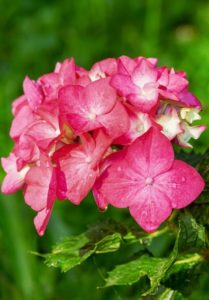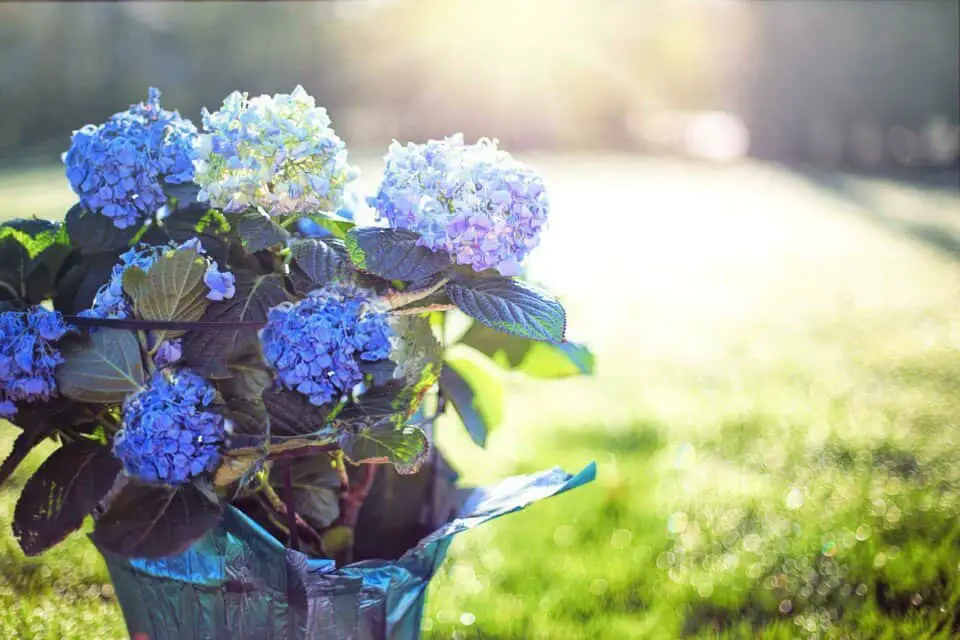Some links in the post are affiliate links and I get a commission from purchases made through some links found in the post.
Hydrangea is a tiny tree or plant resembling a tree. This plant is widespread in the eastern and north-central United States. Subterranean stems, roots, and rhizomes are used to make medicine.
Despite popular belief, there is no scientific evidence to support the use of Hydrangea to treat various ailments, including bladder and prostate infections, prostate enlargement, kidney stones, and more.
Hydrangea may potentially be a health hazard when consumed in high quantities. As well as being a lovely garden addition, this shrub has been used in traditional medicine to help maintain healthy kidneys.
Hydrangea roots serve as both a food source for the plant and a medicinal herb.
A hydrangea does not have deep roots. The roots of a hydrangea are shallow and tend to stay within the top 6 inches of the soil.
Hydrangeas can’t burrow into pipelines or foundations because their thin and fibrous roots are too weak to withstand the seasonal swelling.
What Type of Roots Does a Hydrangea Have?
Hydrangeas (Hydrangea spp.) are shrubs that grow between 3 and 12 feet tall and have clustered flowers that change color depending on the soil’s acidity level.
Strong roots are essential for these deciduous plants, which thrive in USDA plant hardiness zones 3 through 9, to feed and hydrate their lush foliage.
The surrounding environment significantly impacts the Hydrangea’s root growth and spread.
Hydrangea Root Type
 Rhizomes are the primary root structure of Hydrangea. According to Montessori Materials, these roots, also known as underground stems, slowly extend underground as sprouts grow at bud sites.
Rhizomes are the primary root structure of Hydrangea. According to Montessori Materials, these roots, also known as underground stems, slowly extend underground as sprouts grow at bud sites.
A new hydrangea stem, leaf, or flower is formed when the sprouts finally break through the earth and penetrate the root zone.
Rhizomes also develop thin fibrous roots that grow downward in search of water, nutrition, and other essentials.
Rhizomes tend to cluster as your Hydrangea becomes bigger. Digging the cluster and dividing it are also options.
You get two hydrangea plants with the capacity to continue rapid root and leaf growth by planting the separated clumps.
Spread Between Plants
Depending on the kind, you’ll need anywhere from three to ten feet of distance between your hydrangeas. The roots often extend to the plant’s drip line a little farther.
If you want to move a hydrangea from a container to the garden, cut a few roots around the container’s perimeter to liberate the roots.
Root growth increases due to the cutting stress, which releases the plant from its limited stage of development. They should be able to swiftly adapt to their new environment and grow new roots to survive.
Hydrangea Leaf Relationship
Your Hydrangea has to have a vast root spread to make up for the water lost through the leaves’ transpiration.
According to Clemson Cooperative Extension, hydrangeas like full sun with only a few hours of dappled shadow late in the day.
Water vapor seeps through the numerous pores on the vast surface area during the day.
Healthy plants benefit from a greater surface area for water absorption when they have an extensive root system. Toxic levels of wetness can lead to hydrangeas dying off.
How Deep are Hydrangea Roots?
It’s natural to think Hydrangea’s robust stems are matched by a deep and resistant root system under the surface. Hydrangeas have shallow roots.
Like rhododendrons and shrubs, they lack a central taproot. Instead, a root ball is loose, spreading a mass of fibers in its natural growth state.
- The bulk of a Hydrangea’s roots may be found inside the first six inches of soil. However, they tend to disperse quite a bit horizontally. To their dismay, many a gardener had learned this when stray Hydrangea stems began invading their walkways or sprouting stems far from the main bulk of the plants.
- Hydrangeas (Hydrangea spp.) are shrubs that grow between 3 and 12 feet tall and have clustered flowers that change color depending on the soil’s acidity level. Strong roots are essential for these deciduous plants, which thrive in USDA plant hardiness zones 3 through 9, to feed and hydrate their lush foliage. The surrounding environment significantly impacts the Hydrangea’s root growth and spread.
Hydrangeas can’t burrow into pipelines or foundations because their thin and fibrous roots are too weak to withstand the seasonal swelling.
The only danger is if you already have a leaky pipe, in which case the roots of your Hydrangea might get inside and plug it.
Allow ample room for air circulation while growing Hydrangeas near the residence. Putting them right up against the boards isn’t helping them out. For foundation plantings, it’s usually best to avoid using taller cultivars like PeeGees.
How Deep Should Soil be for Hydrangeas?
 In full sun, hydrangeas can thrive if the soil is well-drained and regularly mulched to help retain water. Hydrangea paniculata cultivars have been developed to thrive in whole light and create a stunning display of blooms.
In full sun, hydrangeas can thrive if the soil is well-drained and regularly mulched to help retain water. Hydrangea paniculata cultivars have been developed to thrive in whole light and create a stunning display of blooms.
Plant hydrangeas by digging two feet wider than the root ball. Ensure that the hole you dig corresponds to the size of the root ball and that your plant is no more than an inch or two above the surrounding dirt after it is finished.
By forming a little mound at the plant’s base, it facilitates water drainage.
Moisture Retaining Soil for Hydrangeas in Full Sun
- Hydrangeas thrive in full sun and loam soil, so if you’re fortunate enough to have either, this is the suitable soil medium.
- When it comes to hydrangeas if you have sandy soil or mulch-free soil, forming a small mound near the plant’s base aids in water drainage. Or drain rapidly enough to support the growth of these plants.
- It is recommended that you amend the soil in most sunny gardens before planting hydrangeas so that the soil retains its ideal moisture balance and is sufficiently loose to allow deep roots to develop, making a hydrangea more drought-resistant.
- To keep your soil moist enough to produce hydrangeas, you need to use the following organic materials:
The ability of each of these three organic substances to take in large amounts of water is remarkable.
Despite this, their construction is friable (loose) enough so that excess water will not pool around the roots of your Hydrangea, which would otherwise cause the roots to rot. Moist soil is not the same as wet soil;
therefore, if you have heavy clay in your garden, you need to take precautions to prevent the soil from becoming waterlogged for extended periods after it rains. Moist soil with good drainage is essential.
When it comes to concerns over damage to your home, the shallow roots of your Hydrangeas aren’t necessarily a benefit.
Many trees cause problems because their roots don’t reach very deep—instead of searching for water far below the earth, they spread into leaky basement areas, foundations, or plumbing systems.
However, the term “shallow-rooted” has a different meaning for a tree. Most of your main pipes will be buried at least a foot below the surface if you reside in a colder area. Hydrangea roots seldom go so deep.
Hydrangea root intrusion is more likely due to a plumbing issue than a gardening issue. The roots of any plant will gravitate toward a regular water supply, which is why a leaky pipe is so alluring.
If you’re planning to plant a Hydrangea near a shallow pipe, think about whether the pipe is made of clay, concrete, or PVC.
The latter two are better choices. Infiltration will be more challenging to do with more modern materials. It’s not uncommon for Hydrangea roots to damage a solid foundation but they aren’t as strong as trees roots.
More giant trees with deep, heavy roots pose a more significant threat in this regard. These plants’ roots can stretch and contract in response to changes in moisture or temperature, which can lead to pipe bursts or foundation block cracks.
Hydrangeas should not be planted too close to your home for several reasons, the most important of which is their safety. It is preferable to leave at least three feet between these bushes and any other plants or barriers.
Little Lime, a taller variety, may require as much as 10 feet. Blooms start bright green and become crimson in the fall, making this a miniature version of the popular Limelight variety.
Tough Stuff for the Little Guy. Tiny purple blooms surrounded by bigger ones are produced by this smaller Lacecap Hydrangea.
Mini Penny. Flowers that change color depending on the soil’s acidity make this a popular Mophead.
Glowing Embers.
Mid-sized shrubs that bloom in brilliant shades of pink and scarlet are possible with this plant.
Cityline Rio. Blue blooms with green and purple centers are produced by this dwarf Bigleaf, one of the market’s most compact alternatives.
Regardless of your type, you should presume it will grow to the maximum specified size. As a basic guideline, you should plant your Hydrangea at a distance one and a half times the projected widest part of the plant.
As usual, keep in mind the dangers of sun exposure. Even in cooler climates, Hydrangeas like whole light in the morning and afternoon; however, this preference may vary.
Final Thoughts
 Hydrangea roots penetrate around 6 inches below the surface and require about 3 to 5 feet of room to reach their full potential.
Hydrangea roots penetrate around 6 inches below the surface and require about 3 to 5 feet of room to reach their full potential.
They may grow to 15 feet in height, depending on the type of Hydrangea. Hydrangeas often have short root systems that are not invasive.
The bottom of the planter ought to be equipped with sufficient drainage holes so that excess water can drain away, thereby preventing root rot from occurring.
Additionally essential is adequate drainage. Drainage can also be improved by adding a layer of rocks at the bottom.


